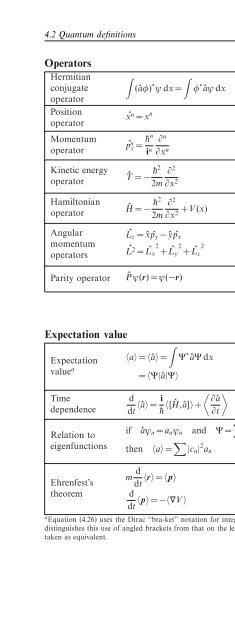Create successful ePaper yourself
Turn your PDF publications into a flip-book with our unique Google optimized e-Paper software.
4.2 Quantum definitions<br />
91<br />
Operators<br />
Hermitian<br />
conjugate<br />
operator<br />
Position<br />
operator<br />
Momentum<br />
operator<br />
Kinetic energy<br />
operator<br />
Hamiltonian<br />
operator<br />
Angular<br />
momentum<br />
operators<br />
∫<br />
∫<br />
(âφ) ∗ ψ dx =<br />
φ ∗ âψ dx (4.17)<br />
ˆ x n = x n (4.18)<br />
pˆ<br />
n x = ¯hn ∂ n<br />
i n ∂x n (4.19)<br />
∂ 2<br />
ˆT = − ¯h2<br />
2m ∂x 2 (4.20)<br />
∂ 2<br />
â Hermitian conjugate<br />
operator<br />
ψ,φ normalisable functions<br />
∗<br />
x,y<br />
complex conjugate<br />
position coordinates<br />
n arbitrary integer ≥ 1<br />
p x<br />
T<br />
¯h<br />
m<br />
momentum coordinate<br />
kinetic energy<br />
(Planck constant)/(2π)<br />
particle mass<br />
Ĥ = − ¯h2<br />
2m ∂x 2 +V (x) (4.21) H Hamiltonian<br />
V potential energy<br />
Lˆ<br />
z = ˆx pˆ<br />
y −ŷpˆ<br />
x (4.22)<br />
Lˆ<br />
2 2 2 2<br />
= Lˆ<br />
x + Lˆ<br />
y + Lˆ<br />
z (4.23)<br />
L z<br />
L<br />
angular momentum along<br />
z axis (sim. x and y)<br />
total angular momentum<br />
4<br />
Parity operator ˆPψ(r)=ψ(−r) (4.24)<br />
ˆP<br />
r<br />
parity operator<br />
position vector<br />
Expectation value<br />
∫<br />
Expectation 〈a〉 = 〈â〉 = Ψ ∗ âΨdx (4.25)<br />
value a = 〈Ψ|â|Ψ〉 (4.26)<br />
Time<br />
dependence<br />
Relation to<br />
eigenfunctions<br />
Ehrenfest’s<br />
theorem<br />
d<br />
dt 〈â〉 = ī 〈 〉 ∂â<br />
h 〈[Ĥ,â]〉+ ∂t<br />
if âψ n = a n ψ n and Ψ = ∑ c n ψ n<br />
(4.27)<br />
then 〈a〉 = ∑ |c n | 2 a n (4.28)<br />
〈a〉<br />
â<br />
Ψ<br />
x<br />
t<br />
¯h<br />
ψ n<br />
a n<br />
n<br />
c n<br />
expectation value <strong>of</strong> a<br />
operator for a<br />
(spatial) wavefunction<br />
(spatial) coordinate<br />
time<br />
(Planck constant)/(2π)<br />
eigenfunctions <strong>of</strong> â<br />
eigenvalues<br />
dummy index<br />
probability amplitudes<br />
m d m particle mass<br />
〈r〉 = 〈p〉 (4.29)<br />
dt r position vector<br />
d<br />
dt 〈p〉 = −〈∇V 〉 (4.30) p momentum<br />
V potential energy<br />
a Equation (4.26) uses the Dirac “bra-ket” notation for integrals involving operators. <strong>The</strong> presence <strong>of</strong> vertical bars<br />
distinguishes this use <strong>of</strong> angled brackets from that on the left-hand side <strong>of</strong> the equations. Note that 〈a〉 and 〈â〉 are<br />
taken as equivalent.


